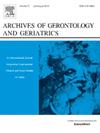脑年龄差距与亚洲队列中身体组成和代谢指标的关联:一项基于mri的研究
IF 3.8
3区 医学
Q2 GERIATRICS & GERONTOLOGY
引用次数: 0
摘要
全球老龄化引起了人们对认知健康、代谢紊乱和肌肉减少症的关注。预防中年人的可逆性衰退和疾病对于促进健康老龄化至关重要。我们假设身体成分的变化,特别是肌肉质量和内脏脂肪,以及代谢指标与大脑加速衰老有关。为了探索这些关系,我们采用脑年龄模型来研究脑年龄差距(BAG)、身体成分和代谢标志物之间的联系。方法利用t1加权解剖脑mri,我们开发了一个机器学习模型,从灰质特征预测脑年龄,对2675名18-92岁的健康个体进行了训练。然后将该模型应用于458名台湾成年人(57.8岁±11.6岁;280名男性)评估BAG、MRI量化的身体成分和代谢标志物之间的关系。结果我们的模型在预测临床数据集中的个体年龄方面具有可靠的通用性(MAE = 6.11年,r = 0.900)。主要发现包括BAG增大与总腹肌面积减少(r = -0.146, p = 0.018)、bmi调整后的骨骼肌指数降低(r = -0.134, p = 0.030)、全身性炎症增加(高敏感性c反应蛋白水平显示)(r = 0.121, p = 0.048)和空腹血糖水平升高(r = 0.149, p = 0.020)之间存在显著相关性。结论我们的研究结果证实,肌肉质量和代谢健康下降与大脑加速衰老有关。改善肌肉健康和代谢控制的干预措施可能减轻脑衰老的不利影响,支持更健康的衰老轨迹。本文章由计算机程序翻译,如有差异,请以英文原文为准。
Brain Age Gap Associations with Body Composition and Metabolic Indices in an Asian Cohort: An MRI-Based Study
Background
Global aging raises concerns about cognitive health, metabolic disorders, and sarcopenia. Prevention of reversible decline and diseases in middle-aged individuals is essential for promoting healthy aging. We hypothesize that changes in body composition, specifically muscle mass and visceral fat, and metabolic indices are associated with accelerated brain aging. To explore these relationships, we employed a brain age model to investigate the links between the brain age gap (BAG), body composition, and metabolic markers.
Methods
Using T1-weighted anatomical brain MRIs, we developed a machine learning model to predict brain age from gray matter features, trained on 2,675 healthy individuals aged 18–92 years. This model was then applied to a separate cohort of 458 Taiwanese adults (57.8 years ± 11.6; 280 men) to assess associations between BAG, body composition quantified by MRI, and metabolic markers.
Results
Our model demonstrated reliable generalizability for predicting individual age in the clinical dataset (MAE = 6.11 years, r = 0.900). Key findings included significant correlations between larger BAG and reduced total abdominal muscle area (r = -0.146, p = 0.018), lower BMI-adjusted skeletal muscle indices, (r = -0.134, p = 0.030), increased systemic inflammation, as indicated by high-sensitivity C-reactive protein levels (r = 0.121, p = 0.048), and elevated fasting glucose levels (r = 0.149, p = 0.020).
Conclusions
Our findings confirm that muscle mass and metabolic health decline are associated with accelerated brain aging. Interventions to improve muscle health and metabolic control may mitigate adverse effects of brain aging, supporting healthier aging trajectories.
求助全文
通过发布文献求助,成功后即可免费获取论文全文。
去求助
来源期刊
CiteScore
7.30
自引率
5.00%
发文量
198
审稿时长
16 days
期刊介绍:
Archives of Gerontology and Geriatrics provides a medium for the publication of papers from the fields of experimental gerontology and clinical and social geriatrics. The principal aim of the journal is to facilitate the exchange of information between specialists in these three fields of gerontological research. Experimental papers dealing with the basic mechanisms of aging at molecular, cellular, tissue or organ levels will be published.
Clinical papers will be accepted if they provide sufficiently new information or are of fundamental importance for the knowledge of human aging. Purely descriptive clinical papers will be accepted only if the results permit further interpretation. Papers dealing with anti-aging pharmacological preparations in humans are welcome. Papers on the social aspects of geriatrics will be accepted if they are of general interest regarding the epidemiology of aging and the efficiency and working methods of the social organizations for the health care of the elderly.

 求助内容:
求助内容: 应助结果提醒方式:
应助结果提醒方式:


